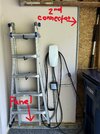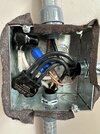I had a 2nd wall connector installed this week by an electrician and setup with power sharing.
Wire from 100A sub-panel, 60A breaker, in basement (thick gray sleeve) to 1st wall connector was cut and spliced with a new wire that runs to the new wall connector on the other side of the garage (steel tube). Splice from existing wire to new one was done via wire nuts and electrical tape inside the steel square junction box.
Power sharing was setup on the existing wall connector as the leader, with the new wall connector as the follower. It quickly installed a firmware update on the follower. Max amps is set to 48A for both connectors so at no time will that be exceeded.
Tested it over the last couple days and it works well. If one Model Y has a low SoC and the other one has a higher SoC, it does seem to initially give the low one a slightly higher amount of amps (27-28A) and lowers the amps on the higher SoC vehicle. However after a few minutes, no more than 5-10 minutes, it equals out to 24A on both until the end of the charging. Once one vehicle finishes charging, the other one ramps up to the full 48A to finish charging. Ideally it would give the low SoC a higher amount of amps, say 35, to "catch up" to the higher SoC vehicle, but since it would just take a matter of hours either way, it's not a concern.
I've reviewed all of these threads and comments regarding the Tesla 'proper' method of installing the power requirements for a second connector, and how Tesla shows the 2 examples in the installation guide of direct from main panel and individual circuits from sub-panel. I've shared this information with my electrician and he's reviewing/researching if it's worth changing the splice junction box into a sub-panel with 2 60A breakers.
I've also contacted Tesla by phone, at the number at the end of the installation guide, and discussed the question. The representative conferred with his peers and could not find any reason why the wire nut spliced junction box isn't acceptable, and confirmed Tesla does not have any specific guidance or requirements for a sub-panel.
I'll post an update if my electrician and I decide to change to a sub-panel. However as it is now, it's working well. Trying to determine any long term concerns by leaving it as is.




